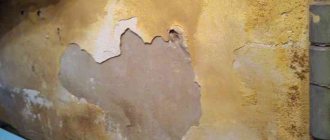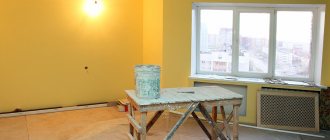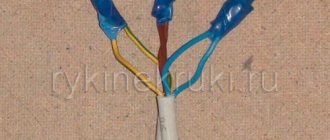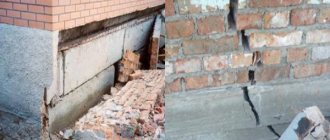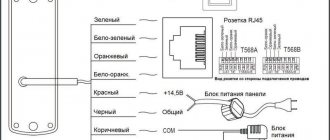We can talk for a long time about all the advantages of hidden wiring, but there is no escaping one of its obvious disadvantages: if the line is damaged, you have to make a lot of effort to find the damaged area. In addition, apartment redevelopment is a fairly common occurrence in modern city “apartments”. To avoid unpleasant surprises, you have to spend a lot of time identifying the line, and without the appropriate knowledge and skills, the risk of making a mistake is greater than ever. How to find a straight electrical wire if it is laid in the wall? There are at least 5 proven ways to do this and we will talk about them today.
- In what cases is a search necessary?
- Method 1. Orientation according to plan;
- Method 2. Visual inspection of the wall;
- Method 3. Radio receiver or regular microphone;
- Method 4. Metal detector;
- Method 5. Special devices;
- Conclusion.
In what cases is a search necessary?
Perhaps hidden wiring
is not the most ingenious way to organize electricity in the house, but nothing better has yet been invented. All its advantages come from the very definition - hidden.
Still, it's damn convenient to use electricity without the sight of dangling cables, alarming fuses and gloomy junction boxes, right? However, in some cases, the main advantage of hidden wiring also turns into its main disadvantage, because it is not so easy to find a direct electrical wire if it is laid in the wall. What are these cases?
- redevelopment
- this has already been mentioned above; quite often there is a need to make changes to the wiring due to a change in the interior; - line damage
is the most painful case, because you not only need to find the wire itself, but also determine the exact location of the break; - drilling
- new elements appear in the interior all the time and it is important to know the location of the wiring for their safe fixation on the wall.
Sudden load fluctuations
A large number of modern instruments and devices, constantly connected to the network and operating in a certain mode, sometimes cause a significant increase in load. They usually don't last long, but at some point they can become critical. Why is this happening?
Modern electrical appliances are much more economical than old household appliances; almost all of them are class A or even A+. But there is one feature - there are many of them and some of them work automatically. They either connect and consume energy, then go into sleep mode and take the minimum from the network. There is a TV in one room, a computer in another, an economical refrigerator hums quietly in the corner, an energy-efficient dryer dries mushrooms, a modern low-consumption air conditioner cools the air, a washing machine does the laundry, and then an A+ class electric boiler started heating the water and the multicooker turned on at a high temperature. your program. At some point, the load may become critical for the home's electrical network.
Method 1. Orientation according to plan
Of course, if the wiring was done in accordance with existing requirements, without any “amateur work,” then in this case you don’t need to think much about how to find the electrical wire in the wall, because there are established rules that strictly regulate its extension. Let's remember them again so that we can easily find the area we need.
- wires in the wall should be placed either vertically or horizontally with building lines;
- the cable is laid from the ceiling slabs at a distance of approximately 150 millimeters;
- if you plan to place the cable along the window beams, then you must retreat from them at least 50 millimeters;
- the distance between the wiring and utilities is approximately 50 millimeters when it comes to water supply and sewerage, about 250 millimeters for gas pipelines and heating.
Elimination of short circuit consequences
If the search for the short circuit was successful, then it’s time to exhale and start eliminating it. What to do next depends on the extent of the damage to the electrical wiring. Regardless of the situation, before starting any repair work, you should definitely turn off the power to the apartment and make sure there is no voltage.
It is necessary to assess how much the cable insulation was damaged at the time of the short circuit. If there are swelling, darkening or melting, the wire must be replaced. If possible, it is necessary to assess its condition along its entire length.
Connecting wires in the distribution box using terminal blocks
If the wire covering is in order, then the immediate location of the short circuit is removed. The surviving ends of the current-carrying conductors are stripped and connected using Wago terminal blocks, welding, soldering or crimping. In low-current circuits, you can use regular fast twisting at your own risk. However, the PUE (7th edition, clause 2.1.21) does not provide for and does not approve of this method of connecting cables.
Method 2. Visual inspection of the wall
Behind the loud name lies a banal examination of the wall with the naked eye. This method is based on the fact that during the organization of hidden wiring, grooves
, into which the cable is later laid. Of course, after the work is carried out, the grooves are carefully masked, but with an interested inspection you can easily find them. So, what needs to be done in order to find an electrical wire laid in the wall in this way?
- tear off wallpaper or any other material that covers the concrete base;
- examine the wall, trying to find traces of the created grooves;
- as a rule, they stand out in a whiter color, and tactile contact with them is characterized by increased roughness.
This is what typical groove marks look like. I think you can find them without difficulty.
Why does an LED spotlight glow when the switch is off?
Why do half the LEDs on the floodlight glow when the switch is off?
Perhaps the neutral wire passes through the switch, while the phase wire is connected directly to the lamp. if the body of the lamp (provided that the insulation in the lamp itself is damaged) or the core passing through the switch (zero) after the switch is in contact with the ground somewhere, the lamp may well burn “at full intensity”. the same effect with a faulty switch - it seems to break the wire, but not completely, it breaks through. As a result, there is a small volt on the lamp, say, 100 - 150. If this is the reason, you need to swap the power wires not at the lamp, but up to the switch.
I personally bet on an insulation breakdown in the lamp itself (the ground goes to the lamps through the body) plus the phase directly, past the switch. check. if the switch breaks zero, swap the wires coming from the panel.
Most likely, if the spotlight is receptacled, then it is either without grounding, or if it is homemade, Chinese, then on the contrary, with grounding. If it is built into a switch without wires, then the switch may have a built-in backlight LED that should be removed and the lighting will stop. It is possible that the path to the LED has burned out and shorted out. It’s hard to say anything without at least a photograph or a more accurate description of the problem.
there are two options! 1st: LED in the switch!
2nd: double switch! (confusion in electrical phase, zero)
In the beginning, you just need to test the spotlight on the table, directly connecting it to the network. Check with a tester whether there is voltage on the body of the spotlight (zero body). If there is no leak, replace the old switch, checking all wiring.
You connected it incorrectly. The switch must break the phase, your zero breaks. This also happens with LED lamps, energy-saving lamps, and fluorescent lamps.
I will answer your question from a technical point of view. Any modern electric boiler from a well-known manufacturer is distinguished by high quality and reliability. The choice can only be based on the design of the device and, of course, the price.
A question of economy. The answer may be this: very approximately, heating ten square meters will require one kilowatt of electricity.
Everything else depends on the heat losses of the house, the quality of the walls, windows, and so on. We need a very competent design of the heating system itself, taking into account all the nuances and subtleties of the structure and electrical wiring capabilities. Only after the project can you begin to select the boiler itself. I cannot give specific advice in recommendations, since I do not know the offer in your region. Let me return to the advice, it is better to choose a well-known manufacturer.
I am not an energy specialist or a theoretical physicist, but my personal opinion is that if there is energy, then it can be converted into electricity, if you have the necessary converters and devices for this. Of course, in our time it is not yet possible to create everything, something simply has not been invented yet, but is already at the stage, something is not yet allowed by our development, something is possible in general humanity will never be able to implement, but theoretically it’s all possible! And leading scientists have spoken about this more than once in their interviews with various media.
Method 3. Radio or regular microphone
If you cannot visually find a direct electrical wire located in the wall, you can use a regular radio or microphone. Both options will allow you to easily find the required area.
Radio
- Any receiver tuned to the range of 100-150 kHz is suitable for searching;
- plug in an electrical appliance with high current consumption;
- bring the receiver to the wall and start moving it along in search of the cable;
- a crackling sound or a constant hiss will indicate the location of the electrical wire.
Microphone
- connect the microphone to the tape recorder;
- We carry out the same manipulations as with the receiver;
- If you heard a crackling or hissing sound or any other noise, it means you found what you were looking for.
Protection measures
It is much easier to prevent a wiring fire in an apartment than to try to recover from the consequences of a fire. Therefore, to prevent wiring fires, certain safety precautions should be observed:
It should be noted that the best way to prevent a fire is a fire alarm. Especially for wooden houses or rooms with flammable finishes. Since it will notify about burning wiring even before the critical spread of the flame. Despite the additional costs, this solution will ensure fire safety for your home.
Method 4. Metal detector
The use of this device is limited by one condition - the wall should not be reinforced concrete. The fact is that the metal detector will not respond adequately to your wall, indicating that there is a cable at almost every point. The correct reaction of a metal detector is based on the fact that the wire is based on non-ferrous metal. Therefore, at the wiring site, the device will “joyfully” notify you of its find.
Light switch won't turn off, could there be a fire?
At one of the European electrical exhibitions at the end of the 19th century, visitors were fascinated by a light switch. Inexperienced viewers were delighted by the simplicity of control - with one movement the lighting was turned on and off. A lot of time has passed, the household switch has become a familiar household item in the apartment, and in production it does not cause surprise. This accessory can be seen everywhere. Sometimes such a device breaks down, you can try to restore it, although the device is inexpensive.
Why doesn't the switch turn off the light when you press a key?
The light switch has stopped turning off the light (that is, whether it is on or off, the light remains on). According to the advice, I replaced the switch (or switch) with a new one and stripped the wires. The problem remains the same - the light just stays on! Help - what could be the next question?
24 comments
Need more information on this issue. Did the switch work, and then suddenly stopped, or after replacing the wiring and installing it, did it stop performing its functions due to improper connection of the junction box. Maybe you have a chandelier with a remote control and the relay unit is simply soldered?
Good afternoon I came home and the light is on in the bathroom, although I remember exactly that I turned it off, and when I flip the switch it doesn’t go out, tell me what could be the reason?
The key on the switch works but the contact is not disconnected, it is stuck, this has happened before. The key can turn off, but the contacts have not opened.
You need to inspect the wires in the distribution box. Perhaps they are stuck to each other.
What if after replacing the switch nothing has changed? Is the light still on?
You need to inspect the wires in the distribution box. They stick to each other over time.
Good evening! Yesterday I turned on the switch (light), but could not turn it off! I had to unscrew the light bulbs, but the switch remained on! What should I do?
Disassemble the switch and see what’s wrong with it, and repair if possible. Or just replace it.
Tell me this is the problem, I changed the spotlight, mistakenly set it to 12 V instead of 220 V, when I turned it on, the lamp exploded, and the switch is always on. and the light from the switch does not turn off. (When pressed, it returns back to on). How to treat?!)
Same problem. How did you decide?
Good afternoon! My daughters were playing with a parrot, suddenly everything went out.. The plugs were knocked out.. We turned on everything, but the light in the children's room does not turn on.. Tell me how to fix it!
Hello! You need to disassemble the switch, look at its contacts, maybe they are stuck. As a last resort, replace it with a new one. You can start by deliberately removing the switch in another room, replacing it with the one with the problem, and if the problem is solved, then buy a new light switch.
Kind. Single-key switch in the bathroom with indicator. 4 ice lamps and a fan are connected. It worked for a year without problems. But one day I unintentionally hit the switch with static electricity with my hand. And that's it, the 4 ice lamps are on constantly, and the fan is on only when this switch is turned on. What about him? Thank you.
I have a similar problem. When the light was turned on, something banged. The light went out, the shield on the distributor was knocked out. I looked at the light bulb - it was burned out. I tried to change it - it was on, but now the light does not turn off. I don’t understand what the problem is, something with the wiring or the switch. I'm afraid that the walls won't have to be hammered, only the renovations have been done, the wiring is all new.
First, try removing the wires from the switch - the light will go out, which means the switch is stuck in the on position - it needs to be replaced.
Good afternoon We connected the web chandelier. When the switch is turned off, the chandelier still burns a little. What should I do?
The diode is on the switches!
I have a strange situation, I came out of the bathroom, turned off the light, and the light started blinking, almost like welding, I clicked the switch, in 2 positions, the welding stopped, but the lamp was still on in both positions of the switch. I pull out the wire responsible for this particular lamp from the 2-toggle switch with LED, the light goes out. I decide to install a new switch, the same one, but a new one and a slightly different color, a 1 in 1 situation. The left button in the corridor turns on the light, but the second button, which should turn on/off the light in the bathroom, does not respond to switching. The LEDs in the switch are both lit normally, not blinking, the right one is only dimmer, but that’s the quality of the workmanship. The switch - Double one way switch - illuminated from Lezard, can be found on Google right away.
Assembly
After repairing the device and preliminary checking its functionality by restoring the current supply, you should install it in its place and assemble its parts in the reverse order. There shouldn't be any particular difficulties in this matter. However, if you still have doubts, you can use the photographic material that you prepared for yourself in advance (even at the disassembly stage). Having started assembling the switch, you first need to connect the wire that we previously highlighted with a marker to one of the terminals, and after that all the remaining wires. At the next stage, the device is fixed in the socket box and the housing rim, decorative cover and light on/off buttons are installed.
When assembling a switch, it often happens that the cover does not want to be attached to the base of the switch. In this situation, you should loosen the bolts holding the housing in the socket box a couple of turns, press the cover tightly to the base and, holding the entire structure, tighten the bolts.
At this point, the process of repairing a switch at home can be considered complete.
Method 5. Special devices
So we have come to the most error-free way to find a direct electrical wire if it is laid in the wall using the hidden wiring method. Such devices are called testers
and are included in the basic toolkit of any electrician. Actually, you yourself can purchase one - and without any fears, redo the wiring, based on the information that the device will provide.
Here is a list of the most popular models that will help you find a wire in the wall and can be easily found on sale:- MS-158M
- the difficulty of working with this tester is due to the fact that it reacts, like a metal detector, to any metal object; - LA-1012
- helps to find wiring in the wall, also provides specific information about the nature of the alternating current; - VP-440
is a very “capable” model that will become a lifesaver if you need to not only find a straight electrical wire laid in the wall, but also determine the location of the circuit break; - GVD-504A
, a popular device among the people, will also transmit all the necessary information about the nature of the alternating electric field. - E121 “Woodpecker”
- used to identify an open circuit, detects cables up to 70 millimeters deep.
What is a short circuit
A short circuit (SC) is an abnormal operation of the electrical network. It is characterized by a sharp jump in current up to hundreds and thousands of amperes. The voltage drops to almost zero. This process is short-lived and usually stops when the circuit breaker trips.
Electrical wiring fault
In an ordinary residential apartment or house, the most common phase conductor short circuit to neutral or ground. At enterprises and in various workshops, short circuits between linear conductors are also encountered. This type of closure is called interphase.
Required Tools
Necessary tools for switch repair
When a spark appears in the switch, it is not necessary to call professional electricians. You can remove simple damage yourself.
To work you will need:
- indicator screwdriver – a model with a light bulb or electronic display is suitable;
- a standard screwdriver, which is used to unscrew screws;
- insulating tape;
- fine-grained sandpaper;
- pliers;
- marker;
- stationery knife for removing the insulating coating from the cable.
Before starting repairs, you need to know the design of the device. The switches are produced in a plastic case and have internal operating units and a frame. It is attached to the device with screws or latches. The main mechanism is located in the socket box and is secured with spacers or screws.
To make the contacts easier to access, you will need to remove the outer part from the switch.
Overloads as an emergency mode of operation of electrical equipment
Overload
This is called
an emergency mode
in which currents arise in the conductors of electrical networks, machines and devices that for a long time exceed the values allowed by the standards.
One of the types of transformation of electrical energy is its conversion into heat. Electric current in the conductors of electrical networks, machines and devices releases heat, which is dissipated in the surrounding space. Conductors can reach dangerous temperatures. Thus, for bare copper, aluminum and steel wires of overhead lines, the maximum permissible temperature should not exceed 70°C. This is explained by the fact that with increasing temperature, oxidative processes intensify and oxides with high resistance are formed on the wires (especially in contact connections); The contact resistance increases, and, consequently, the heat generated in it. As the connection temperature increases, oxidation increases, and this can lead to complete destruction of the wire contact.
The cause of
overload may be caused by incorrect calculation of conductors during design. If the cross-section of the conductors is underestimated, then when all the provided electrical receivers are turned on, an overload occurs. Overload may occur due to the additional inclusion of electrical receivers for which the network conductors are not designed.
To avoid overload or its consequences, during design it is necessary to correctly select the cross-sections of network conductors according to the permissible current, as well as electric motors and control devices.
During the operation of electrical networks, you cannot turn on additional electrical receivers if the network is not designed for this.
Actions in case of electrical fire
Electricity is an integral part of every person’s life, which makes life easier and more comfortable. However, if certain rules for using electricity are not followed or working with faulty electrical appliances can lead to property damage or pose a threat to human life and health. For example, many people live in houses that were built several decades ago, and the electrical wiring of the premises remains from those times. Of course, the condition of such electrical wiring leaves much to be desired, and if the wires are not replaced in time, a fire may occur, which in the worst case may develop into a fire.
How can you extinguish live wiring?
It happens that when an electrical wiring catches fire, there is no person nearby and it is impossible to quickly put out the flames. In these cases, in order to prevent a fire, it is necessary to act quickly and it is not always possible to run to the electrical panel to turn off the power to the house. A fire in its initial stages can be extinguished using earth and sand. But for such emergencies, it is better to have a special fire extinguisher in the house. Not all types of this device can be used to extinguish live appliances and electrical wiring. Therefore, before purchasing, you need to figure out which fire extinguisher can extinguish electrical wiring.
The best option is a carbon dioxide fire extinguisher, which can be used to extinguish fires in electrical installations under voltage up to 10,000 V. The extinguishing agent has a low temperature and is supplied under high pressure. Due to this, it is possible not only to eliminate the fire, but also to cool the smoldering sections of the electrical wiring. The main disadvantage of this device is that the vapors released during evaporation are harmful to human health. Therefore, it is prohibited to use a carbon dioxide fire extinguisher to extinguish fires in unventilated areas.
For apartments and private houses where the network voltage does not exceed 380 V, a good option would be to purchase a powder fire extinguisher, which can be used to extinguish electrical installations under voltage up to 1000 V. The powder agent quickly eliminates the fire by isolating the source of the flame from oxygen.
If it is possible to turn off the power, you can use water and foam fire extinguishers. Otherwise, you cannot extinguish electrical wiring with such means, because a person can be electrocuted. When extinguishing a fire, a distance of 1 meter must be maintained.
Prevention measures
If the electrical installation rules were followed when installing electrical wiring, then proper handling of electrical appliances minimizes the risk of wire fires. However, you cannot be 100% sure on this issue, and to prevent possible problems it is better to follow the recommendations described below.
You cannot use many tees and extension cords; it is advisable to lay the cord from them along the walls so that people do not step on it or heavy objects are placed on it. You need to know that the maximum current for a single-phase socket is 16 A. If this threshold is exceeded, the current protection may not work and the socket will become dangerous.
It is necessary to inspect junction boxes several times a year. The contacts are checked for the strength of the connection, and the oxidation layer, if one has formed, is cleaned.
It is necessary to monitor the condition of the sockets and periodically check the reliability of the clamping contacts. Worn-out products may begin to spark, which can subsequently cause a fire and develop into a fire.
Heating electrical appliances that are turned on must be constantly monitored. If you need to leave the house for a long time, you can turn off the electricity supply at the electrical panel.
Transition resistances
Transitional
are called
resistances
in places where current passes from one contact surface to another through the areas of their actual contact
.
In such a contact connection, a certain amount of heat is released per unit time, proportional to the square of the current and the resistance of the areas of actual contact.
The amount of heat generated can be so significant that the transition resistances become very hot. Consequently, if heated contacts come into contact with flammable materials, they may ignite, and contact of these places with explosive concentrations of flammable dust, gases and vapors of flammable liquids will cause an explosion.
To increase the areas of actual contact between the contacts, it is necessary to increase their compression forces by using elastic contacts or special steel springs.
To remove heat from points of contact and dissipate it into the environment, contacts with sufficient mass and cooling surface are required.
Thus, to ensure safe working conditions in existing electrical installations
a set of measures should be provided that are implemented at all stages - before the start, during the implementation and at the completion of the work. Activities mean the organization of certain actions in electrical installations (registration of work, appointment of those responsible, preparation of the work site, conducting briefings, etc.), as well as specific manipulations with electrical installation devices (switching, checking the presence or absence of extinguishing in live parts, installation of protective grounding and others). In addition, it is worth taking into account local conditions and applications of electrical installations.
Considered causes of fires
are relevant. Today, a person cannot do without machines, installations and computers. Every year, as practice shows, the use of electrical installations is increasing, and the sooner measures to prevent fires are developed and taken, the safer the future awaits us.
Using a hearing aid
Using old hearing aids, such as the AK-1 brand, you can find hidden wiring with fairly high accuracy. You set the device to “telephone” mode - it is needed so that a person who is hard of hearing can freely talk on the phone in a noisy environment. In this case, the device becomes susceptible only to electromagnetic waves , which is what we need. Bring the sensor to the intended location of the hidden wiring and record the noise.
Why do you need to know where the wires go?
When remodeling an apartment, you often have to look for hidden cables in the structural elements of the building. External wiring in home improvement today is used extremely rarely, and only as a design solution. Hidden electrical wiring is the safest because it is placed in grooves and covered with plaster on top.
Hidden wiring is a reliable and safe solution for any home
If the wire is damaged during drilling, a short circuit will occur, and the worker may also receive an electric shock. In addition, this will lead to additional expenses, since you will have to open the wall, replace the damaged cable and seal the groove back hermetically.
This question is relevant in the following situations:
- apartment redevelopment;
- complete or partial replacement of wiring;
- accidents.
The wires are laid horizontally and vertically, and turns are always made at an angle of 90°. Thanks to these rules, you can determine by eye where approximately they pass.
It is necessary to find out the location of the wiring during repair work.
How and with what to extinguish a burning wiring?
To extinguish fires on elements or sections of the electrical network that are energized, it is strictly prohibited to use water. Since if it comes into contact with a person, there is a risk of electric shock. Therefore, to extinguish fires in electrical installations defined by the classification in paragraph 1 of GOST 27331-87, only fire extinguishers are used that use aerosol, carbon dioxide, or powder as extinguishing material.
Figure 4: extinguishing electrical installations
But they also make it possible to fight fires only in devices up to 1 kV. And all electrical installations over 1 kV must first be de-energized.
Source
Why the socket cracks and sparks: potential causes and repair methods
Sockets are simple and usually reliable devices. Correctly installed devices function flawlessly and therefore do not require replacement for a long time. However, there are no eternal things, so sooner or later problems arise in the electrical network circuit. Most often, owners encounter warning symptoms - the appearance of sparking and a characteristic crackling sound. This situation is extremely dangerous because it can cause a fire. Therefore, first the owner of the “naughty” mini-device needs to find out why the socket is cracking and sparking, and then try to solve the problem on his own, or call a specialist.
